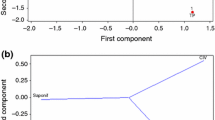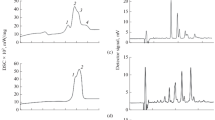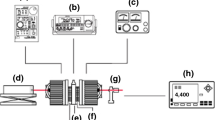Abstract
Vegetable oils can undergo changes in their physical and chemical properties when they are subjected to processes such as extraction, purification, cooking, frying, or chemical modifications that are required depending on their application in the food industry. In the present research, different methods were used to determine physical, chemical, and thermal properties of avocado, sesame, extra virgin flaxseed, extra virgin olive, and grape seed oils, in order to evaluate and compare the compositional effects of each vegetable oil. By using an adiabatic scanning calorimeter, an alternative calorimetric method, the specific heat of five vegetable oils was obtained as a function of the temperature, in the range of 25–90 °C. The fatty acid profile was determined via gas chromatography. Monounsaturated acids present in avocado and extra virgin olive oil cause higher specific heat values in these oils, and the presence of polyunsaturated acids, contained mainly in extra virgin flaxseed oil, reduces the specific heat values. We found an almost linear behavior of vegetable oil specific heats, as a function of the temperature, and the slopes of these linear fits depend on the contained percentage of polyunsaturated fatty acids in the vegetable oil. The unsaturated acids are an important factor to analyze the behavior of specific heat of vegetable oils. The obtained specific heat values were compared with the estimation from the Rowlinson–Bondi equation, for specific heat of vegetable oils, giving a very good adjustment, mainly in a temperature range near to the room temperature.



Similar content being viewed by others
References
Keefe SFO, Pike OA. Fat characterization. In: Nielsen SS, editor. Food analysis. chapter 14, 4th ed. USA: Springer; 2010. p. 239–60.
IUPAC-IUB, Nomenclature C on B. The nomenclature of lipids, chemistry and physics of lipids. Arch Biochem Biophys. 1968;123:409–15.
Potter NN, Hotchkiss JH. Food Science. 5th ed. Berlin: Springer; 1995.
Caballero B, Trugo L, Finglas P. Encyclopedia of food sciences and nutrition. 2nd ed. Amsterdam: Elsevier Science B.V.; 2003.
Bazinet RP, Layé S. Polyunsaturated fatty acids and their metabolites in brain function and disease. Nat Rev Neurosci. 2014;15:771–85.
Castro González MI. Ácidos grasos omega-3: beneficios y Fuentes. Interciencia. 2002;27:128–36.
DeFilippis AP, Sperling LS. Understanding omega-3’s. Am Heart J. 2006;151:564–70.
FAO. Fats and fatty acids in human nutrition Joint FAO/WHO. Ann Nutr Metab. 2009;55:1–308.
Gogus U, Smith C. n-3 Omega fatty acids: a review of current knowledge. Int J Food Sci Technol. 2010;45:417–36.
Simopoulos AP. The importance of the ratio of omega-6/omega-3 essential fatty acids. Biomed Pharmacother. 2002;56:365–79.
Sánchez P, Segundo MJ. Omega 7: su papel en el cuidado de la piel y las mucosas. Offarm: Farmacia y. Sociedad. 2007;26:58–67.
Hernández AG. Tratado de nutrición: Bases fisiológicas y bioquímicas de la nutrición. 2nd ed. Médica Panamericana; 2010.
Coupland JN, McClements DJ. Physical properties of liquid edible oils. J Am Oil Chem Soc. 1997;74:1559–64.
Tan CP, Che Man Y. Differential scanning calorimetric analysis of edible oils: comparison of thermal properties and chemical composition. J Am Oil Chem Soc. 2000;77:143–55.
Fasina OO, Colley Z. Viscosity and specific heat of vegetable oils as a function of temperature: 35 °C to 180 °C. Int J Food Prop. 2008;11:738–46.
Formo MW. Physical properties of fats and fatty acids. Bailey’s Ind Oil Fat Prod. 1979;1:177–232.
Bockisch M. Vegetable fats and oils. Fats and oils handbook. Hamburg: AOCS Press, Urbana II; 1998. p. 174–344.
AOCS. Official methods and recommended practices of the AOCS, 3rd printing. 6th ed. Sallee EM, Hopper TH, Link WE, Walker RO, Firestone D, Mehlenbacher VC, editors. AOCS Press; 2010.
Dieffenbacher A, Pocklington WD. Standard methods for the analysis of oils, fats and derivatives: 1st supplement to the 7th edition. 2nd ed. Oxford: Blackwell Scientific; 1992.
Morad NA, Kamal AAM, Panau F, Yew TW. Liquid specific heat capacity estimation for fatty acids, triacylglycerols, and vegetable oils based on their fatty acid composition. J Am Oil Chem Soc. 2000;77:1001–5.
Bicanic D, Chirtoc M, Dadârlat D, Van Bovenkamp P, Van Schayk H. Direct determination of thermophysical parameter √Kpc in mayonnaise, shortening, and edible oil. Appl Spectrosc. 1992;46:602–5.
Lazzari M, Chiantore O. Drying and oxidative degradation of linseed oil. Polym Degrad Stab. 1999;65:303–13.
Santos JCO, Santos IMG, Conceição MM, Porto SL, Trindade MFS, Souza AG, et al. Thermoanalytical, kinetic and rheological parameters of commercial edible vegetable oils. J Therm Anal Calorim. 2004;75:419–28.
Dweck J, Sampaio CMS. Analysis of the thermal decomposition of commercial vegetable oils in air by simultaneous TG/DTA. J Therm Anal Calorim. 2004;75:385–91.
Cruz-Orea A, Pitsi G, Jamée P, Thoen J. Phase transitions in the starch-water system studied by adiabatic scanning calorimetry. J Agric Food Chem. 2002;50:1335–44.
Tripathi CSP, Losada-Pérez P, Glorieux C, Kohlmeier A, Tamba MG, Mehl GH, et al. Nematic-nematic phase transition in the liquid crystal dimer CBC9CB and its mixtures with 5CB: a high-resolution adiabatic scanning calorimetric study. Phys Rev E. 2011;84:041707.
Losada-Pérez P, Tripathi CSP, Leys J, Glorieux C, Thoen J. Large heat capacity anomaly near the consolute point of the binary mixture nitromethane and 3-pentanol. J Chem Phys. 2011;134:044505.
Contreras-Gallegos E, Dominguez-Pacheco FA, Hernández-Aguilar C, Carballo-Carballo A, Cruz-Orea A, Thoen J, et al. Study of thermal and structural properties of starch granules from different maize genotypes. Food Biophys. 2015;10:19–24.
NMX-F-101-1987. Alimentos. Aceites y grasas vegetales o animales. Determinación del índice de acidez. Foods. Vegetables or animals oils and fats. Acidity index determination. Normas mexicanas. Dirección General de Normas.
NMX-F-154-1987. Alimentos. Aceites y grasas vegetales o animales. Determinación del índice de peróxido. Foods. Vegetables or animals oils and fats. Peroxide index determination. Normas mexicanas. Dirección General de Normas.
PANREAC. Analíticos en alimentaria Métodos oficiales de análisis: Aceites y grasas. Panreac Química, S.A.; 1999.
Qian MC, Pike OA. Fat characterization. In: Nielsen SS, editor. Food analysis laboratory manual. Berlin: Springer; 2010. p. 103–13.
NMX-F-408-S-1981. Alimentos para humanos. Aceites y grasas vegetales o animales. Determinación del índice de yodo por el método de Hanus.
NMX-F-174-S-1981. Alimentos para humanos. Determinación del índice de saponificación en aceites y grasas vegetales o animales. Foods for humans. Determination of the saponification index in oils and vegetal or animal fats. Normas Mexicanas. Dirección General.
Thoen J. Thermal investigations of phase transitions in thermotropic liquid crystals. Int J Modern Phys B. 1995;9:2157–218.
Aparicio R, Roda L, Albi MA, Gutiérrez F. Effect of various compounds on virgin olive oil stability measured by Rancimat. J Agric Food Chem. 1999;47:4150–5.
Ozdemir F, Topuz A. Changes in dry matter, oil content and fatty acids composition of avocado during harvesting time and post-harvesting ripening period. Food Chem. 2004;86:79–83.
NMX-F-002-1985. Alimentos. Aceite comestible puro de ajonjolí. Foods edible pure sesame oil. Normas mexicanas. Dirección General de Normas.
Codex Alimentarius Commission. Codex Standard for Olive Oils, and Olive Pomace Oils, Codex Stan 33-1981. Codex Alimentarius. Roma, Itália: Secretary of the Codex Alimentarius Commission Joint FAO/WHO Food Standards Programme; 2003.
Beare-Rogers J, Dieffenbacher A, Holm JV. Lexicon of lipid nutrition (IUPAC Technical Report). Pure Appl Chem. 2001;73:685–744.
Zarrouk W, Baccouri B, Taamalli W, Trigui A, Daoud D, Zarrouk M. Oil fatty acid composition of eighteen Mediterranean olive varieties cultivated under the arid conditions of Boughrara (southern Tunisia). Grasas Aceites. 2009;60:500–8.
Crews C, Hough P, Brereton P, Godward J, Lees M, Guiet S, et al. Quantitation of the main constituents of some authentic sesame seed oils of different origin. J Agric Food Chem. 2006;54:6266–70.
Gunstone FD. Vegetable oils in food technology. Food technology. Oxford: Blackwell; 2011.
Elleuch M, Besbes S, Roiseux O, Blecker C, Attia H. Quality characteristics of sesame seeds and by-products. Food Chem. 2007;103:641–50.
Yermanos DM, Hemstreet S, Saleeb W, Huszar CK. Oil content and composition of the seed in the world collection of sesame introductions. J Am Oil Chem Soc. 1972;49:20–3.
Henna Lu FS, Tan PP. A comparative study of storage stability in virgin coconut oil and extra virgin olive oil upon thermal treatment. Int Food Res J. 2009;16:343–54.
Gutfinger T. Polyphenols in olive oils. J Am Oil Chem Soc. 1981;58:966–8.
NMX-F-052-SCFI-2008. Aceites y grasas-aceite de aguacate-especificaciones. Fats and oils-avocado oil-specifications.
Firestone D. Physical and chemical characteristics of oils, fats, and waxes. 3rd ed. Champaign, IL: AOCS press; 2006.
Codex Alimentarius Commission. Codex standard for named vegetable oils. Codex Stan 210-1999. Codex Alimentarius. Roma, Itália: Secretary of the Codex Alimentarius Commission Joint FAO/WHO Food Standards Programme; 1999.
World Food Programme. Technical Specifications for the manufacture of: Fortified Refined Flaxseed Oil. 2011.
Shahidi F, editor. Edible oil and fat products: processing technologies. Bailey’s industrial oil and fat products. Wiley-Interscience; 2005. p. 586.
Nykter M, Kymäläinen HR, Gates F, Sjöberg AM. Quality characteristics of edible linseed oil. Agric Food Sci. 2006;15:402–13.
Pardo JE, Fernández E, Rubio M, Alvarruiz A, Alonso GL. Characterization of grape seed oil from different grape varieties (Vitis vinifera). Eur J Lipid Sci Technol. 2009;111:188–93.
Santos JCO, Santos MGO, Dantas JP, Conceição MM, Athaide-Filho PF, Souza AG. Comparative study of specific heat capacities of some vegetable oils obtained by DSC and microwave oven. J Therm Anal Calorim. 2005;79:283–7.
Samyn P, Schoukens G, Vonck L, Stanssens D, Van den Abbeele H. Quality of Brazilian vegetable oils evaluated by (modulated) differential scanning calorimetry. J Therm Anal Calorim. 2012;110:1353–65.
Pardauil JJR, de Molfetta FA, Braga M, de Souza LKC, Filho GNR, Zamian JR, et al. Characterization, thermal properties and phase transitions of amazonian vegetable oils. J Therm Anal Calorim. 2016.
Li R, Huang J, Huang L, Teng J, Xia N, Wei B, et al. Comparison of GC and DSC monitoring the adulteration of camellia oil with selected vegetable oils. J Therm Anal Calorim. 2016.
Hwang LS. Sesame oil, Chapter 12. Bailey’s industrial oil and fat products. Vol 6. 6th ed. 2005.
Yin W, Huixiao L, Guiming F, Xueyang C, Feng C, Xiea M. The relationship of antioxidant components and antioxidant activity of sesame seed oil. Sci Food Agric. 2015;95:2571–8.
Poling BE, Prausnitz JM, O’Connell JP. Properties of gases and liquids. 5th ed. New York: McGraw-Hill; 2000.
Rihani DN, Doraiswamy LK. Estimation of heat capacity of organic compounds from group contributions. Ind Eng Chem Fundam. 1965;4:17–21.
McKetta JJ. Phosphorus to pipeline failure: subsidence strains chemical processing and design. Encyclopedia of chemical processing and design, vol. 36. London: CRC Press; 1990.
Acknowledgements
The authors acknowledge the partial economic support from CONACYT through Project No. 241330, and also the support of Instituto Politécnico Nacional through COFAA, EDI, and BEIFI scholarships. We also thank Ing. Esther Ayala Maycotte, IBQ. Ma. Dolores Díaz Cervantes and Ing. Miguel Márquez Robles for their technical support at the Physics and Biotechnology Department, CINVESTAV-IPN.
Author information
Authors and Affiliations
Corresponding author
Rights and permissions
About this article
Cite this article
Contreras-Gallegos, E., Domínguez-Pacheco, F.A., Hernández-Aguilar, C. et al. Specific heat of vegetable oils as a function of temperature obtained by adiabatic scanning calorimetry. J Therm Anal Calorim 128, 523–531 (2017). https://doi.org/10.1007/s10973-016-5864-1
Received:
Accepted:
Published:
Issue Date:
DOI: https://doi.org/10.1007/s10973-016-5864-1




